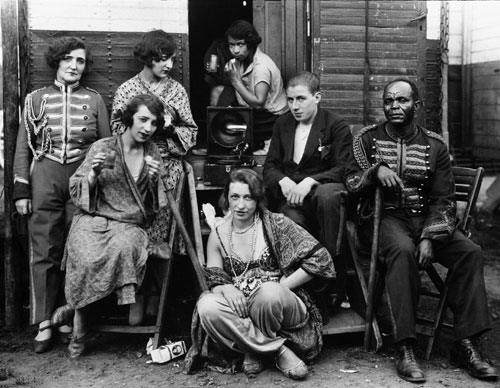A colleague showed us a video from youtube. A newly-married couple came out of a church. The camera panned along the street. There was a brief glimpse of a young girl looking out of a window, curious to see what was happening. She could have been any girl of 12 or 13, watching the adult world and anticipating her own future. This young girl's life is well-documented and her diary is translated into numerous languages. Her name was Anne Frank. She wasn't quite sixteen years old when she died in Bergen-Belsen concentration camp.
For most of the photographs of August Sander, now on display at Leicester's New Walk Museum, as part of a touring exhibition sponsored by the Art Fund, viewers can know little of how people began or ended. Sander's initial aim was to present a study of German life, using individuals to represent different types within German society. But however determined Sander's categorisation, the people he photographed resist being mere types. Some perform their occupations, often surprisingly. A farmer in the 1920s still ploughs with oxen Another, in 1952, sows seed by hand, scattering it from a basket. Others pose with the implements of their trade. Almost all gaze straight into the camera, leaving the viewer with no more information that the brief labels provide. The more I look, the more I understand the impossibility of reading a whole human being from a face.
I never have the sense that Sander's photography mocks or diminishes its subjects. I always see them as complex, interesting human beings. If I wish, I can build stories. I have to set those stories in the time through which they lived. Almost all of them were confronted by the dilemmas and persecutions of Nazism. But when I start wondering "How did that farm-worker vote?" or "What did that woman do when the Nazis came to power?" I can't answer the questions I want to ask. People's actions don't always harmonize with their faces. An SS officer in one of the photos of Nazis looks benevolent and slightly unsure of himself. His uniform does not.
I can and do make guesses. Some of the circus people in the photo above are plainly not Aryans. I hope they got away. I would like to imagine a happy future for the gypsies, the children with severe disabilities, those who are simply labelled "persecuted people" or "political prisoners." But I know most didn't get away. The exhibition ends with a portrait of the death mask of Sander's son Erich, who died towards the end of his ten-year jail sentence. Escapes are temporary. None of us ever walks out of history or politics, however hard we try. I wonder what future generations will think, if they ever look back on photographs, film and videos of the time in which we live.
August Sander didn't lead the life that was mapped out for him at childhood. He was supposed to be a miner. One day, working at the mine, he helped a visiting photographer and looked through the lens of a camera. He never forgot what he saw - the sky, the movement of clouds. That moment gave birth to one of the great photographers of the twentieth century. He was part of his time but the records he made speak to the future.
I have paid one visit to the August Sander exhibition so far. I hope to visit at least once a week while the exhibition is in Leicester. I want to look more closely at many of the portraits. I would like to commit them to memory, which is another way of letting the people of the past live on. I also want to spend more time on Sander's pictures of human hands and of landscapes.
But I can't spend too long in the gallery with Sander's pictures. There's too much humanity there, real people set to face a dreadful future.
I think if I stayed too long, I would cry.
Subscribe to:
Post Comments (Atom)


No comments:
Post a Comment